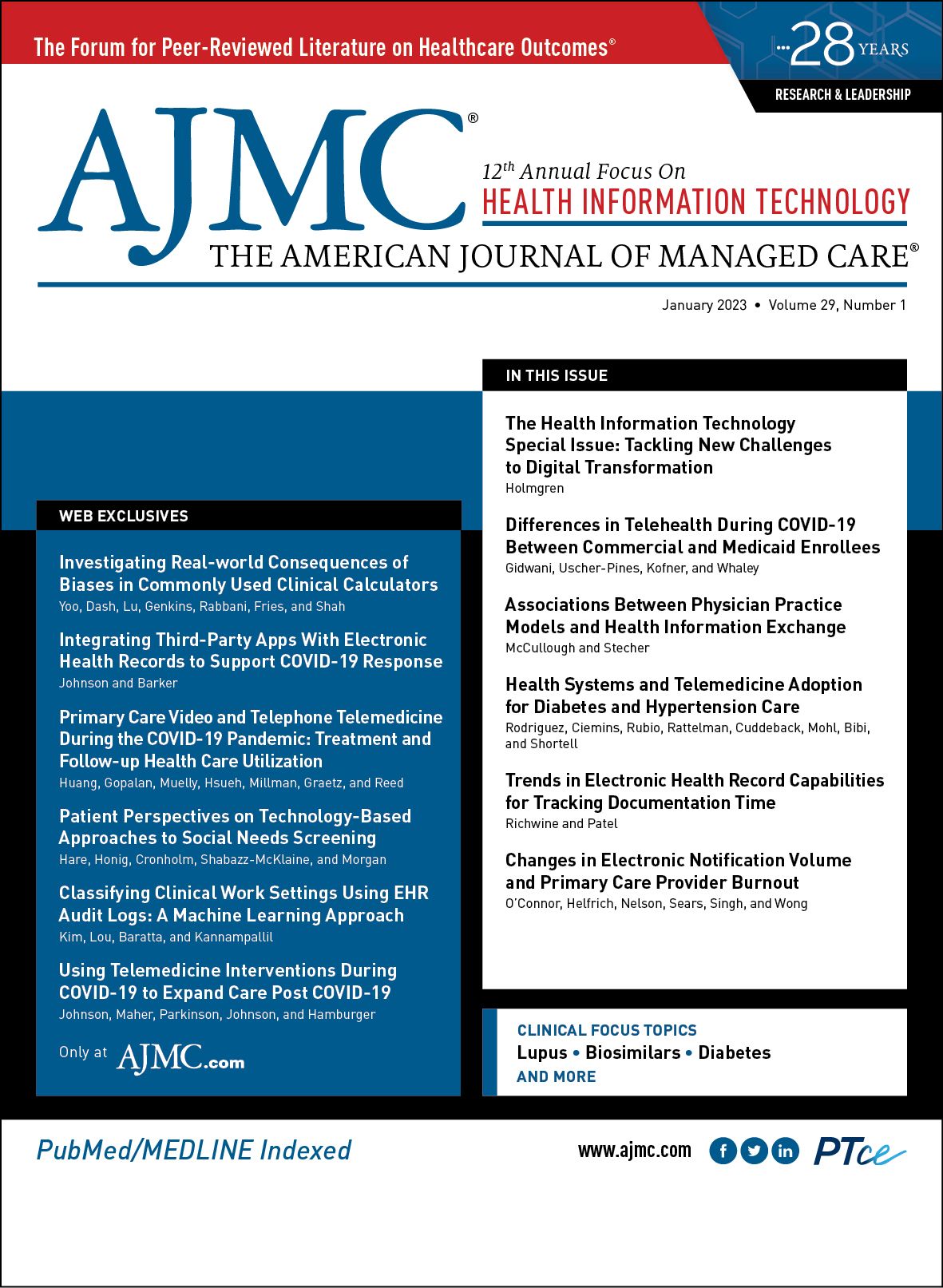Publication
Article
The American Journal of Managed Care
The Health Information Technology Special Issue: Tackling New Challenges to Digital Transformation
Author(s):
A letter from the guest editor highlights the potential for the findings in this special issue help us take steps toward realizing the promise of information technology in health care.
Am J Manag Care. 2023;29(1):17-18. https://doi.org/10.37765/ajmc.2023.89299
Over the past 12 years that The American Journal of Managed Care® has published the annual Health Information Technology special issue, the landscape of digital health has changed dramatically. Although the march of technological progress had come slowly to health care organizations, 2 events spurred seismic changes. First, the rapid adoption of electronic health records (EHRs) in response to federal policy has digitized care delivery, bringing with it a host of intended and unintended consequences for patients, clinicians, and health care organizations. Second, the onset of the COVID-19 pandemic forced an immediate and sudden shift to the organization and delivery of health care—a shift that was only possible because of the digital infrastructure built by broad EHR adoption. In this special issue, 11 papers advance our understanding of health information technology across 3 domains, each of which reflects those 2 events: telemedicine, EHR work and clinician burden, and the building of a better digital health system.
Evaluating the Telemedicine Revolution
The popularity of telemedicine exploded at the onset of the pandemic, and virtual care is likely here to stay in some form. Johnson et al use qualitative data from expert panels to highlight the challenges and barriers to continued use of telemedicine in rheumatology, identifying important issues around regulation and reimbursement as potential pitfalls for sustainable telemedicine policy. Rodriguez et al study differences in practice adoption and use of telemedicine for diabetes and hypertension, finding that smaller practices were less likely to continue delivering care virtually by late 2020—highlighting the importance of providing technical support for small practices. Using claims data from California, Gidwani et al find significant differences in use of telehealth by payer, with Medicaid enrollees more likely to use telehealth and managed care enrollees in both commercial and Medicaid plans having a higher rate of telehealth use compared with their fee-for-service peers, suggesting that payers play an important role in the modality of care patients select. Finally, Huang et al dive into the differences between video and audio-only telemedicine visits, finding more intense prescribing and lower rates of 7-day follow-ups for video calls. Together, these studies help build the evidence base necessary to craft a successful long-term telemedicine strategy.
Electronic Health Records: Workflow and Burden
Although EHRs have delivered a wide range of benefits—including serving as a key piece of digital infrastructure that enabled the rapid pivot to telemedicine at the onset of the COVID-19 pandemic—broad adoption has come with unintended consequences. Perhaps most salient is the volume of EHR work, ranging from alert fatigue to documentation burden, for frontline clinicians. O’Connor et al use data from the Veterans Health Administration to assess whether changes in daily inbox notifications were associated with primary care physician burnout, without finding a strong relationship—suggesting EHR-related burnout is multifaceted and difficult to attribute to one specific issue. Richwine and Patel use data from the American Hospital Association annual survey to track hospital use of an increasingly important data source, EHR audit log metadata, that quantifies clinician time spent in the EHR. They found that most hospitals had access to these data, especially those with market-leading vendors, and are increasingly using those data to identify areas of improvement for clinical workflow and targeting EHR training and support. Finally, Kim et al use that increasingly popular EHR audit log for an innovative research purpose: predicting and classifying clinical work settings, a foundational task to using EHR metadata for applied research. The EHR plays a central role in care delivery—and the ongoing clinician burnout crisis—and impactful studies on how to reduce EHR burden are critical to chart a path forward in a digital health system.
Building a Better Digital Health System
Although broad EHR adoption has built the infrastructure for digital transformation, there are myriad ongoing issues that need robust evidence to inform policy makers and practitioners. McCullough and Stecher tackle the complex interplay between value-based payment reform and health information exchange (HIE) for office-based physicians, finding that payment reform participants were more likely to participate in HIE, but significant barriers remained to full connectivity. Johnson and Barker evaluate the proliferation of EHR-integrated health apps following the onset of the COVID-19 pandemic, finding a significant increase, especially in apps focused on telehealth. This highlights the potential of EHRs as information technology infrastructure that allows third-party innovators to build software leveraging EHR-based clinical data. Using qualitative interviews, Hare et al investigate patient perspectives on using technology to capture data on social needs, finding that patients were generally accepting of technology-enabled screening, especially if they felt they had a trusted relationship with their clinician. Another unintended consequence of digital transformation is that technology can exacerbate bias. Yoo et al evaluate the performance of commonly used calculators that function as clinical decision aids, finding that many measures of calculator performance do not convey variability across demographic subgroups, and the authors recommend that health care organizations routinely perform stratified analyses of the performance of their digital tools to ensure that technology does not deepen disparities.
Conclusions
Although the US health system has broadly digitized care delivery, developing new ways to use those data to improve care delivery is an ongoing process. The research findings highlighted in this special issue help us move forward in overcoming obstacles—from pandemics to clinician burnout—and take steps toward realizing the promise of information technology in health care.






